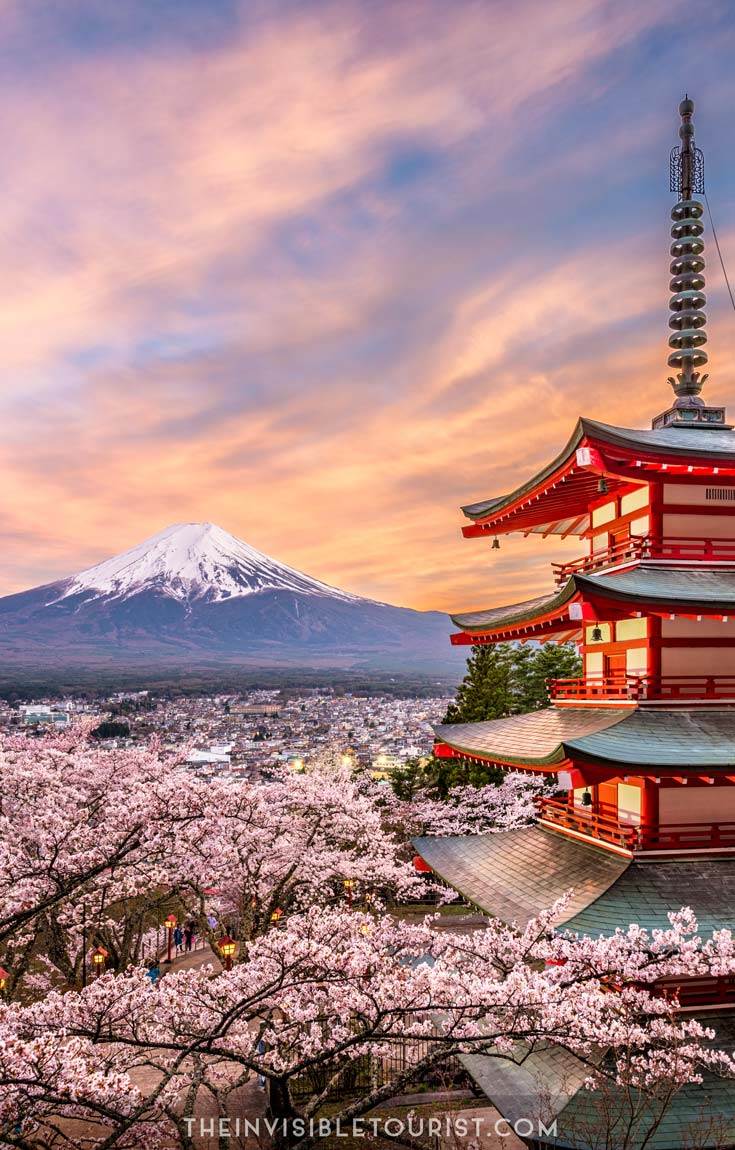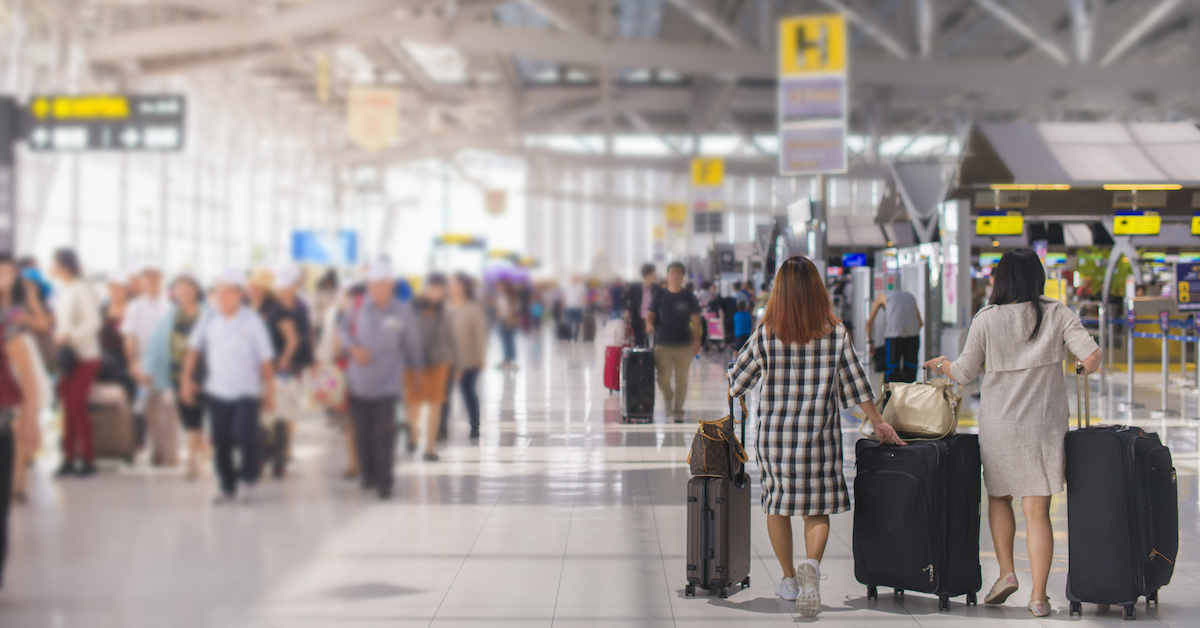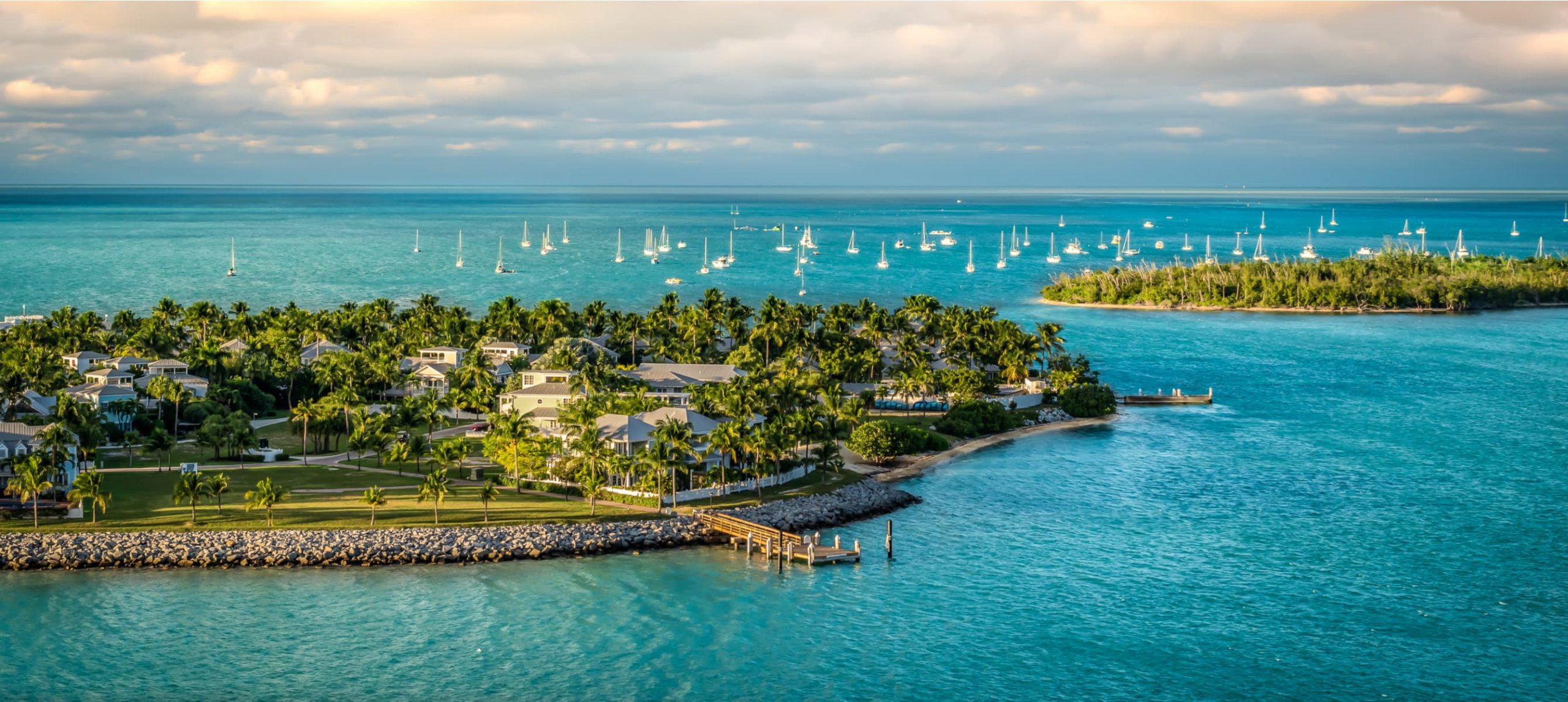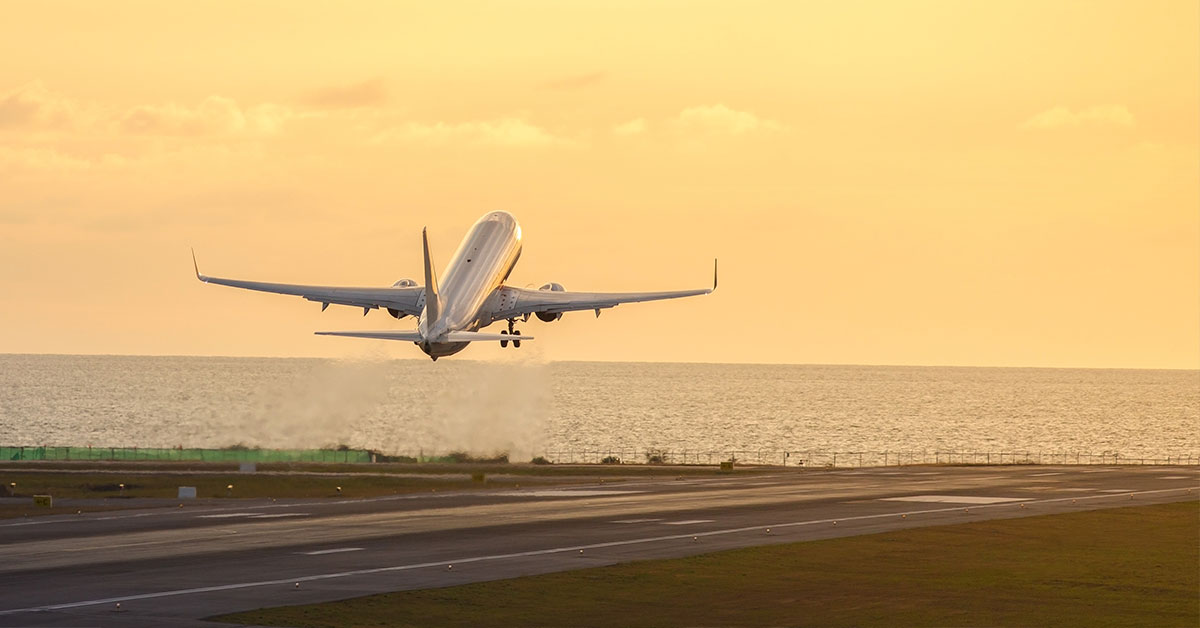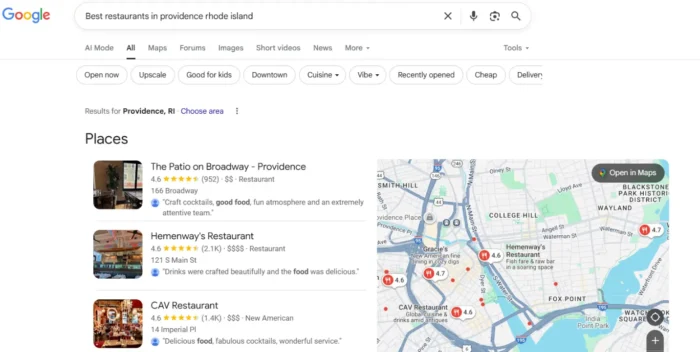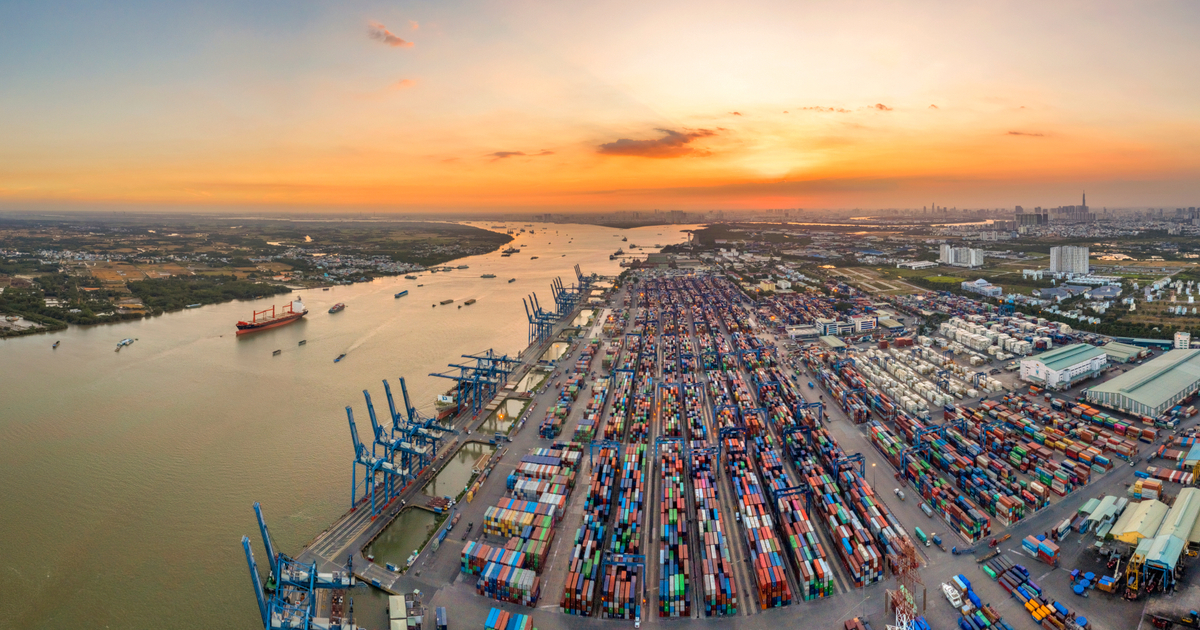2 Weeks in Japan Itinerary: Complete Guide for First-Timers
“Travel. It leaves you speechless then turns you into a storyteller” ~ Ibn Battua. Why spend 2 weeks in Japan? If you’ve read my article explaining the many things Japan is famous for, you may have been inspired to...
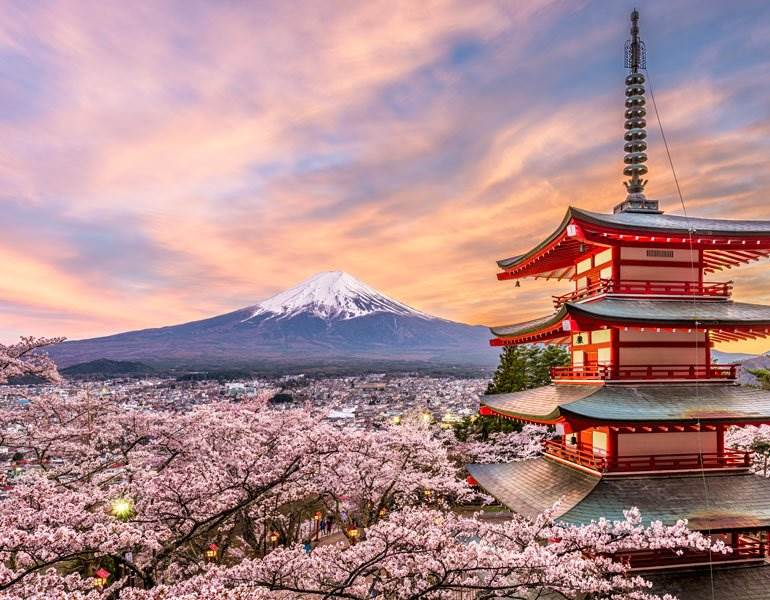
“Travel. It leaves you speechless then turns you into a storyteller” ~ Ibn Battua.
If you’ve read my article explaining the many things Japan is famous for, you may have been inspired to plan your visit! For first-timers, 2 weeks in Japan is the perfect introduction to this beautiful country’s unique history, culture and stunning landscapes.
There aren’t many destinations in the world that have managed to blend past and present so seamlessly as Japan. Sometimes it can feel as though you’re living in the ancient past and the distant future at the same time, you’ll soon find out why!
Spending 2 weeks in Japan allows you to get a taste for much of the country (and maybe leave you wanting more). My first-timers guide below focuses on Japan’s “Golden Route”: Major cities such as Tokyo, Kyoto, Osaka and Hiroshima, as well as day trips to experience the beauty of Mt Fuji and the ancient traditions of Nara and Miyajima.
TIP: Curious to see where an extra week can take you? My Japan 3 week itinerary covers the Old and New Golden Routes so take a look once you’re done here.
NOTE: As this guide focuses on the Golden Route, I’ve created separate guides for Japan’s off the beaten path destinations, hidden gems and cultural experiences in Japan.
So, why should you trust me? I’m a geek who loves researching a destination to death before I visit! My preference is to be organised and aware of what to expect when travelling and I’m passionate about sharing my findings with you so you can make the most of your trip, too. For you book lovers, I created my itinerary with these Japan travel books.
Here’s some highlights of what you can expect to experience during your visit:
 2 WEEKS IN JAPAN HIGHLIGHTS ~ 1: Be stunned by vibrant signs and buildings in Electric Town, Tokyo ~ 2: Reflect on consequences of war at the Atomic Bomb Dome, Hiroshima ~ 3: Wander the tranquil Bamboo Groves, Kyoto ~ 4: Make friends with sacred deer, Nara ~ 5: Explore beautiful Osaka Castle & Museum, Osaka ~ 6: Visit Japan’s largest Torii Gate at Itsukushima Shrine, Miyajima ~ 7: Enjoy the world’s best wagyu beef, everywhere! ~ 8: Explore the peaceful mountainside at Fushimi Inari, Kyoto.
2 WEEKS IN JAPAN HIGHLIGHTS ~ 1: Be stunned by vibrant signs and buildings in Electric Town, Tokyo ~ 2: Reflect on consequences of war at the Atomic Bomb Dome, Hiroshima ~ 3: Wander the tranquil Bamboo Groves, Kyoto ~ 4: Make friends with sacred deer, Nara ~ 5: Explore beautiful Osaka Castle & Museum, Osaka ~ 6: Visit Japan’s largest Torii Gate at Itsukushima Shrine, Miyajima ~ 7: Enjoy the world’s best wagyu beef, everywhere! ~ 8: Explore the peaceful mountainside at Fushimi Inari, Kyoto.TL;DR If you prefer a visual summary of this 2 week Japan itinerary, take a look at this 60 second video below. Psst, if you can’t see it simply disable your ad blocker:
Don’t worry, I’ve included the tiny details about the best way to travel to each destination, as well as how to get around once you’re there so you can be confident on your trip. If you’re interested to learn how to spend an efficient 2 weeks in Japan without feeling rushed, read on for more!
This 2 weeks in Japan itinerary and guide will cover:
Exploring Japan on your own How to spend 2 weeks in Japan on a mid-range budget Quick links to useful resources Complete 2 Weeks in Japan itinerary, day-by day guide including costs, things to do, where to stay, where to eat and getting around for: Days 1-5: Tokyo (including day trip to Mt Fuji) Days 6-10: Kyoto Days 10-12: Hiroshima (including day trip to Miyajima) Days 12-14: Osaka (including day trip to Nara) Ideas for day trips from Tokyo Day 15: Transit to Tokyo Buy the ad-free PDF version of this 2 Week Japan itinerary for offline use → Things to keep in mind about your two weeks in Japan Flights to Tokyo Do I need a Japan Railpass? How to catch the shinkansen in Japan Types of shinkansen explained How much time you can save using Nozomi shinkansen Purchasing Nozomi shinkansen tickets Busy Periods and Public Holidays in Japan for 2020/21 Japanese Etiquette: Do’s and don’ts when visiting Japan Conclusion 2 weeks in Japan cost overall for two adultsThis post contains affiliate links, at no extra cost to you. I may receive a small commission if you click through and make a purchase.
Exploring Japan on your own has never been easier
If you’re planning a trip to Japan you may be overwhelmed on where to start and wondering how you’ll get around (isn’t there a language barrier?!) so I’ll reveal the tips and tricks I used for my own 2 weeks in Japan itinerary. Below you’ll find ideas for day trips, my hotel recommendations and what you could expect to see in a day at each destination. Hopefully it will inspire you for your own trip and get your itinerary planning off to a good start!
This is a lengthy post so grab yourself a cuppa and get comfortable ☕
Heads up: As Japan has become such a popular destination in recent years, it helps if you are aware of issues the influx of tourists have on local communities. Here’s what you can do to help curb overtourism in Japan plus 10 easy solutions for how to travel and avoid contributing overtourism issues at any destination.

How to best spend 2 weeks in Japan on a mid-range budget
To really be an Invisible Tourist on any trip, staying in a centrally located hotel is of utmost importance if you want to maximise your travel experience. In Japan it means you’ll spend less time getting around and more time exploring UNESCO World Heritage Sites (7 in this itinerary), wandering the vibrant streets and enjoying the culinary delights that make Japan world-famous.
The hotels I’ve recommended below are mid-range, in the heart of the city centres and only a few moments walk to Metro stations.
Also, make use of Shinkansen – Japanese Bullet Trains. They are the most efficient way to get around Japan. I’ll discuss these in more detail at the conclusion of this itinerary.
TIP: If you’re hoping to visit during the cherry blossom season, my detailed guide to spring in Japan is packed with tips for more places to go, alternatives to popular spots, what to pack and how to avoid the huge crowds!
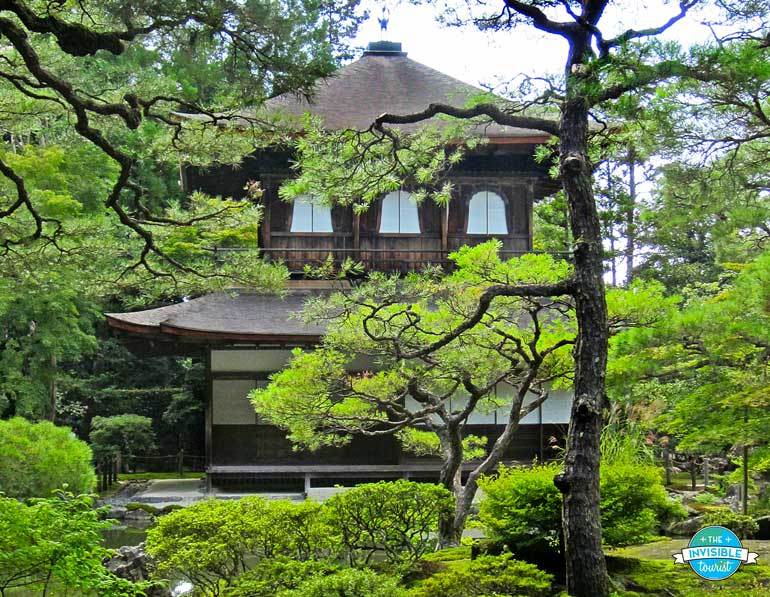
Quick links to useful resources
Here’s a quick summary of resources you may find useful for your trip to Japan.
Learn 20 crucial travel tips you must know in my detailed Japan travel planning guide. There’s lots of talk about the Japan Rail Pass. I personally didn’t use one for reasons I mention in this itinerary, but if you’ve done the math and figured out it’s best for you, make sure you buy your JR Pass in advance. These passes aren’t available once you’ve arrived in Japan! Just make sure to leave enough time for it to be posted to you before your trip. If you enjoy being organised you can also buy a Suica card in advance to use on the Tokyo Subway as soon as you arrive in Japan. After not using it before, after my recent Japan trip I’ve totally converted from not having pocket wifi to making it a must! It’s dirt cheap and possible to pre-book your pocket wifi hire and pick it up from an airport of your choice when you arrive in Japan. It’s super easy and convenient, too! Tickets for teamLab Borderless, Robot Restaurant, Tokyo Disneyland & DisneySea, Hakone Free Pass, Universal Studios Osaka, Studio Ghibli Museum and many more passes can be purchased in advance online. This will save you loads of hassle and wasted time lining up when you’re there so be sure to take a look! I’ve written in detail about is Klook legit? if you’re interested to learn more. If you’re a foodie, you may like to take an authentic Japanese cooking class! Hosted by locals, there’s no better way to learn more about Japan and its culture than through food. Read about my ramen cooking class in Kyoto for more info.One last thing before we dive into the 2 weeks in Japan itinerary! To help you overcome the language barrier in Japan, I’ve created a FREE PDF Cheat Sheet of useful Japanese phrases you’ll need on a daily basis. Go take a look ⬇️
Are you ready? Let’s do this!
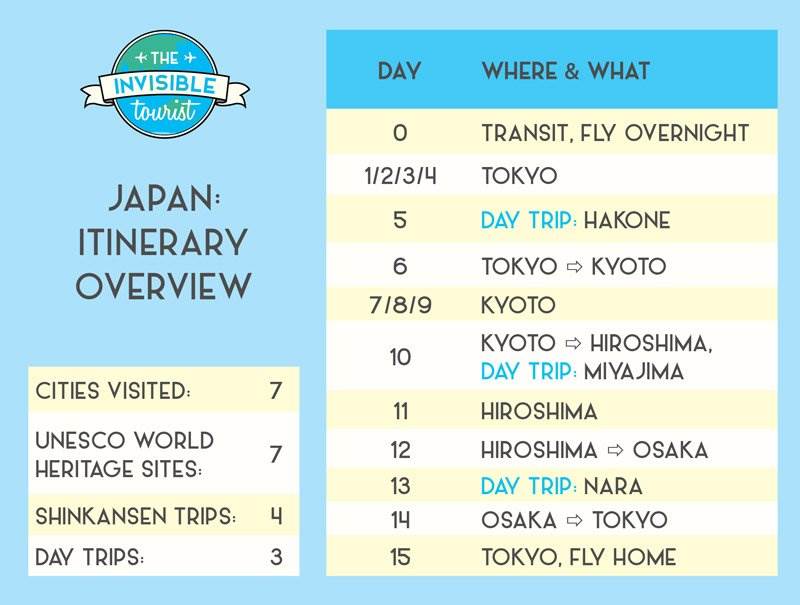

 Pin me to Pinterest for easy reference later! 📌
Pin me to Pinterest for easy reference later! 📌Day 0: TRANSIT
Fly to Tokyo overnight and get excited about where you’ll be waking up tomorrow!

Days 1 – 5: TOKYO
A little word of advice: Don’t underestimate the sheer size of Tokyo. It will be one of the largest cities you ever visit, with many attractions spaced out in different neighbourhoods. It’s good to know what you want to see before you go so you can plan ahead accordingly. This will help you to not feel rushed during your visit and you’ll enjoy every minute!
How to get to Tokyo from Narita Airport
Getting there: Narita Airport to Tokyo via Narita Express, approx. 1 hour.
Cost: Adult Narita Express Ticket JPY 3,020 ea
A popular option is also the Narita Airport Limousine Bus. At almost half the cost of Narita Express, you’re able to book tickets in advance! For more information and prices, click here to book your Narita Airport Limousine tickets.
How to get to Tokyo from Haneda Airport
Getting there: Haneda Airport to Tokyo (Hamamatsucho) via Tokyo Monorail, 15 minutes.
Cost: Adult JPY 500 ea
Your IC/Suica Card will cover the cost of the monorail, too! It’s easy to pre-purchase your Suica card and have it mailed to you before your trip so you’re ready to roll on arrival in Tokyo.
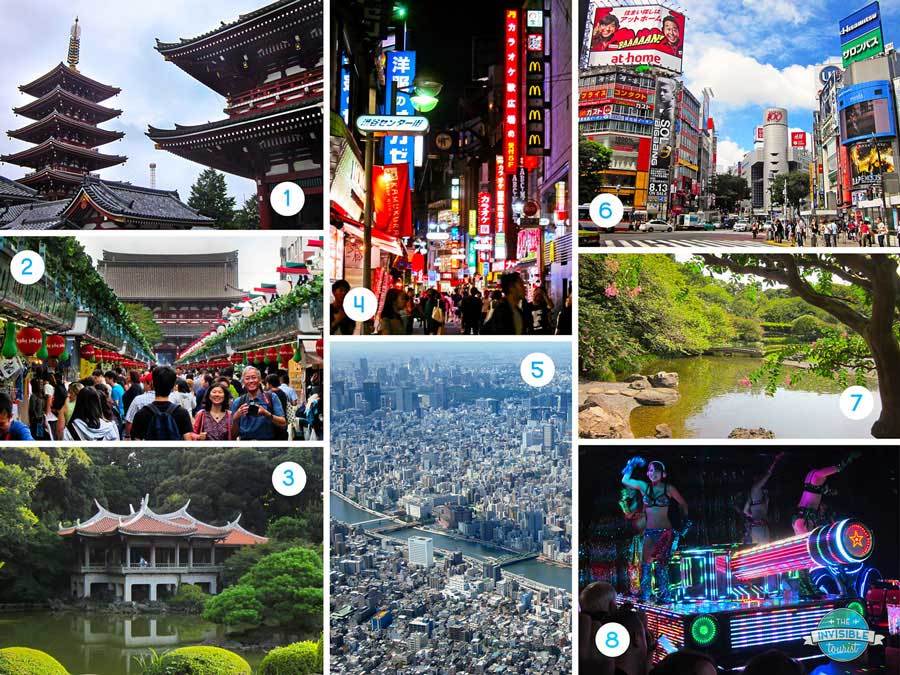 TOKYO HIGHLIGHTS: 1 & 2: Senso-ji Temple ~ 3: Shinjuku Gyoen ~ 4: Shinjuku ~ 5: View from Tokyo Skytree ~ 6: Shibuya Crossing ~ 7: Tokyo Imperial Palace Gardens ~ 8: Robot Restaurant
TOKYO HIGHLIGHTS: 1 & 2: Senso-ji Temple ~ 3: Shinjuku Gyoen ~ 4: Shinjuku ~ 5: View from Tokyo Skytree ~ 6: Shibuya Crossing ~ 7: Tokyo Imperial Palace Gardens ~ 8: Robot Restaurant


Where to eat in Tokyo
My personal favourite places to eat in Tokyo are Han No Daidokoro (incredible wagyu beef BBQ) in Shibuya, Kirin City izakaya in Shibuya, Crepes in Harajuku, Maidreamin’ in Akihabara, around the Golden Gai and Omoide Yokocho in Shinjuku.
If you’re after a quick bite, I love and recommend Japanese kombini (convenience stores) or street food. My guide to snacks from Japan details the popular and traditional morsels to try, plus exactly where to find them!
Things to do in Tokyo
Spend your first day discovering Shibuya 渋谷 by crossing “The Scramble” (world’s busiest street crossing – some 3,000 people use it at any one time). Then head up to the brand new Shibuya Sky for a bird’s eye view of the city. Wander through the quirky shops on Takeshita-dori, Harajuku 原宿. While you’re in the neighbourhood, the tranquil grounds of Meiji Jingu, Tokyo’s major Shinto shrine, are definitely worth a visit. Explore Shinjuku 新宿 Station (busiest station in the world) and its bustling streets then escape to Shinjuku Gyoen for some tranquility in the busy city. Discover Senso-ji Temple at Asakusa 浅草 then visit Akihabara 秋葉原 Electric Town for anime and electronics. Start your night off at the amazing Robot Restaurant ロボットレストラン (read my experience here). Take the trip up Tokyo Skytree 東京スカイツリー then spend the afternoon strolling Tokyo Imperial Palace 皇居 gardens. Start your morning off by spending a few hours being blown away by teamLab Borderless. Check out Odaiba‘s お台場 Statue of Liberty and Rainbow Bridge along Tokyo Bay. Hamarikyu Gardens in Minato 港区 are also stunning to visit and enjoy a traditional cup of matcha tea in the lakeside teahouse. Spend the afternoon wandering the streets in Ginza 銀座 and admiring the designer shops and funky architecture. If you want to discover some more ideas for places I haven’t mentioned here, head over to my guide to Tokyo’s hidden gems – a fun collaboration I did with YouTube’s Pretty Pastel Please!TIP: For even more ideas than listed here, check my detailed guide to places to go in Tokyo – it even includes fun activities and cultural experiences you can enjoy around the Olympic venues. You can also check out my guide to iconic streets in Tokyo to include during your trip.

 TOP: Incredible teamLab Borderless, Odaiba ~ BOTTOM: Sensory overload at the Robot Restaurant, Shinjuku
TOP: Incredible teamLab Borderless, Odaiba ~ BOTTOM: Sensory overload at the Robot Restaurant, ShinjukuMore things to do in Tokyo
Wander around Shiba Park and visit the Tokyo Tower, an icon of the city. Did you know its orange and white frame is modelled loosely on the Eiffel Tower? You can also buy tickets in advance to skip the line at the Tokyo Tower Observation Deck! Pay your respects to children at Zojo-ji Temple.TIP: Experience Tsukiji Fish Market with a local guide
Tsukiji Fish Market is the largest wholesale fish market in the world! Once attracting over 40,000 visitors per day, the Inner Market that hosted the tuna auction and wholesale produce has been closed off to tourists since October 2018. However, you can still visit the Tsukiji Outer Market in Toyoso on your own, but part of the allure of this attraction was the ability to watch the tuna auction.
A local guide can provide access to the auction on a Tuna Auction & Fish Market tour. If you prefer to skip the auction, still find out the best foodie recommendations on aTsukiji Fish Market Foodie walking tourand make the most of your time. If you’re a seafood lover, you won’t want to miss sampling all the street food on these tours!
You can learn more about how to be a conscious consumer of bluefin tuna and other seafood during your visit.


 TOP & MIDDLE: Zojo-ji Temple & Tokyo Tower ~ BOTTOM: Tokyo SkyTree from Asakusa
TOP & MIDDLE: Zojo-ji Temple & Tokyo Tower ~ BOTTOM: Tokyo SkyTree from AsakusaOPTIONAL: Day Trip from TOKYO to HAKONE
Hakone is a popular adventure, however there are so many options to see Mt Fuji and other side trips. Be sure to read my full guide to day trips from Tokyo, some of them I’m sure you haven’t heard of!
Moving on to Hakone, the easiest way to see all the sights is to do the Hakone Round Course with the Hakone Free Pass. It includes a combination of train, cable car, ropeway, boat and bus to see lakes, hot springs, active volcanoes, art galleries and gardens. Highlights are the Picasso Museum, Open Air Museum and Mount Fuji (if she decides to peep out from behind the clouds!)
For pricing and more information on the Hakone Free Pass click here!
Getting there: Tokyo Shinjuku to Hakone-Yumoto stations via Odakyu Express, approx 75mins.
Cost: Adult JPY 2,280 ea (including Limited Express surcharge).
TIP: Sit on the right side of the Odakyu Express from Tokyo to get the best view of Mount Fuji as you speed past.
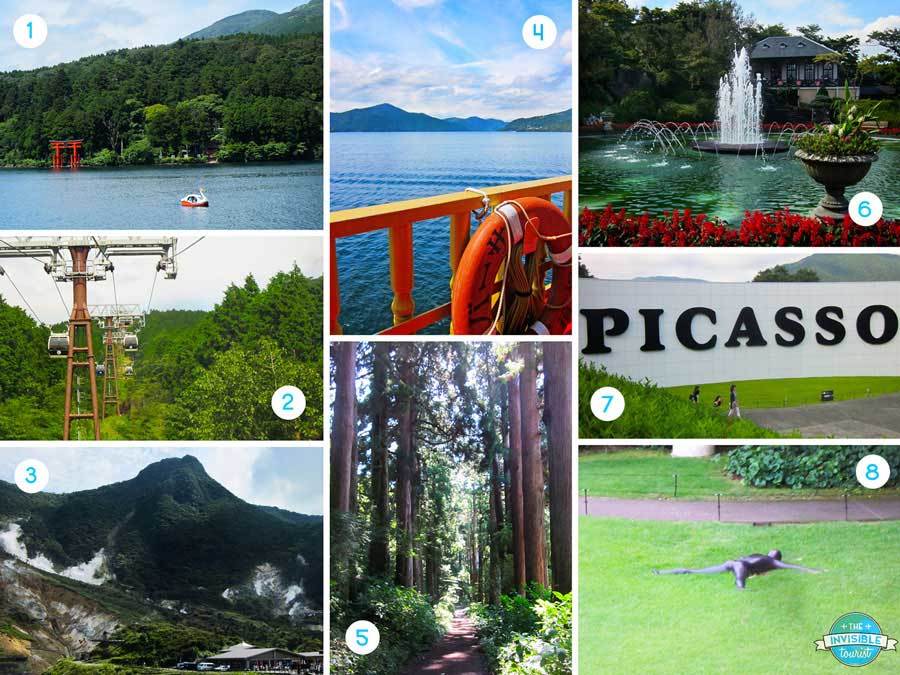 HAKONE HIGHLIGHTS: 1: Lake Ashi ~ 2: Hakone Cable Car ~ 3: Sulphur mines ~ 4: Sailing Lake Ashi ~ 5: Cedarwood Forest ~ 6: Botanic Gardens ~ 7: Picasso Museum ~ 8: Open Air Museum
HAKONE HIGHLIGHTS: 1: Lake Ashi ~ 2: Hakone Cable Car ~ 3: Sulphur mines ~ 4: Sailing Lake Ashi ~ 5: Cedarwood Forest ~ 6: Botanic Gardens ~ 7: Picasso Museum ~ 8: Open Air MuseumREAD MORE:
The Best Tokyo to Mt Fuji Day Trip Itinerary
10 Secret Tokyo Hidden Gems You Never Heard Of
Amazing Day Trips from Tokyo You Haven’t Thought Of
20+ Essential Tips You Must Know When Planning a Trip to Japan
The Best Time to Visit Japan for Cherry Blossoms
Hida No Sato Folk Village: Takayama’s Delightful Crown Jewel

DAYS 6 – 10: KYOTO
With over 1600 temples and shrines, dear old Kyoto deserves more than just one day of your time! There is so much more to see in Japan’s old capital than the ever-popular Fushimi Inari Taisha, Kinkaku-ji (Golden Pavilion) and Kyomizu-Dera. Get ready to experience a different side of Kyoto by uncovering some hidden gems over 4 days.
Getting from Tokyo to Kyoto
2 hours 20 minutes from Tokyo Shinagawa station on Nozomi shinkansen
Cost: Adult Nozomi ticket JPY 13,910 ea or free with the Japan Rail Pass.
 KYOTO HIGHLIGHTS: 1: Arashiyama Bamboo Grove ~ 2: View from Sanjo Ohashi Bridge ~ 3: Daigo-ji Temple ~ 4: Kinkaku-ji Temple ~ 5: Fushimi Inari Shrine ~ 6: Backstreets of Gion ~ 7: Gio-ji Moss Gardens ~ 8: Kiyomizu-Dera
KYOTO HIGHLIGHTS: 1: Arashiyama Bamboo Grove ~ 2: View from Sanjo Ohashi Bridge ~ 3: Daigo-ji Temple ~ 4: Kinkaku-ji Temple ~ 5: Fushimi Inari Shrine ~ 6: Backstreets of Gion ~ 7: Gio-ji Moss Gardens ~ 8: Kiyomizu-Dera

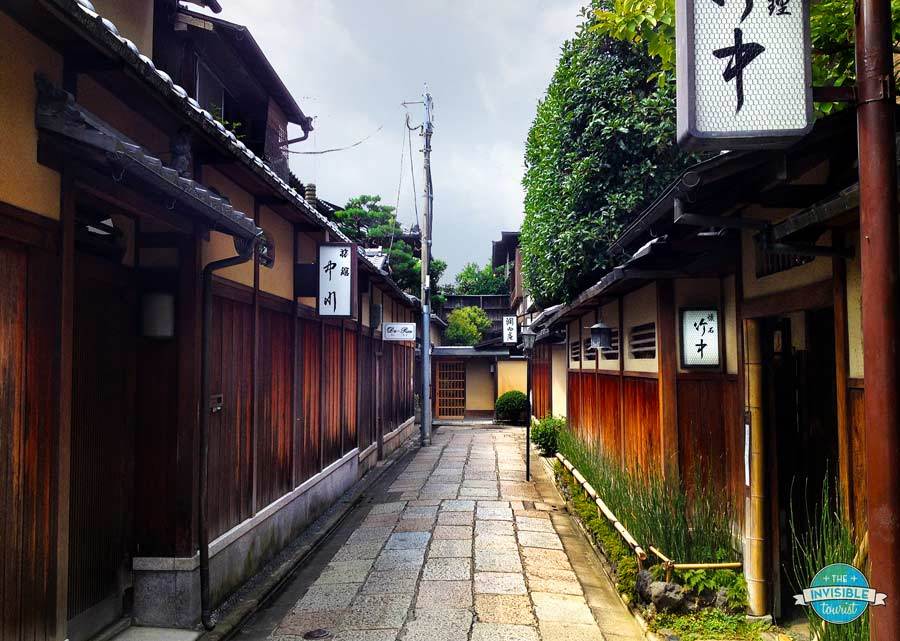
Where to eat in Kyoto
Manzara-Tei in Pontocho Alley and any restaurant in Gion ぎおん alleyways (Geisha district). One of the best ways to discover where to eat in Kyoto is to take the advice of a local. During my recent visit, I took this Kyoto night tour and was able to find hidden bars in the Pontocho area. On the pub crawl, I even got to sample a special “rose sake” that I wouldn’t have been able to find by myself! Read more in my bar hopping in Kyoto at night article.
It’s also possible to to do a cooking class combined with a tea ceremony in Kyoto (some you are able to dress up in a traditional kimono, too!). Click here for all combined traditional Kyoto cooking classes and tea ceremonies.
Things to do in Kyoto
Explore downtown Kyoto 京都 and walk along the Sanjo Ohashi Bridge 三条大橋. Start at Arashiyama 嵐山 Bamboo Grove then walk to Gio-ji Temple & Moss Gardens 祇王寺, Adashino Nembutsu-ji 化野念仏寺, then finish the day at famous Kinkaku-ji Temple 金閣寺 (Golden Pavilion), a UNESCO World Heritage site. The Golden Pavilion is perhaps Kyoto’s biggest drawcard.Begin the day at stunning Daigo-ji 醍醐寺 temple & gardens followed by Nanzen-ji 南禅寺 gardens. Nanzen-ji features a massive working aqueduct that dates back to the mid-19th century. Spend the afternoon strolling the Philosopher’s Path north to Ginkaku-ji 銀閣寺 (Silver Pavilion). The Silver Pavilion is said to be the little brother of Kinkaku-ji (Golden Pavilion) and in my opinion had the more exquisite gardens! After that big walk you may want to take a taxi back to your hotel (around 20mins, approx. 2,400 JPY from memory).
Maruyama Park 円山公園 in the morning, wander the backstreets of Gion ぎおん ensuring you stop by Sannen-zaka & Ninnen-zaka streets for some stunning hand-crafted souvenirs on your way to Kiyomizu-Dera 清水寺 (UNESCO World Heritage site). Spend the afternoon at Fushimi Inari Shrine 伏見稲荷大社 (Thousand Torii Gate), a UNESCO World Heritage site you’re sure to recognise.TIP: Fushimi Inari literally sits on the side of a mountain. Be prepared for loads of walking because the sign at the start is NOT to scale! If you want to avoid the crowds but don’t want to get up at the crack of dawn, this Fushimi Inari hidden hike with a Kyoto local guide might be up your alley.
BONUS: Check out “Gear”, an incredible non-verbal performance exclusive to Kyoto. The characters really come to life and tell a story through music, magic tricks, various choreography routines and colourful lighting. It’s very enjoyable!


READ MORE:
Kyoto Hidden Gems You Won’t Want To Miss
What to Except at a Traditional Kyoto Tea Ceremony
16 Stunning Places to Discover in Japan Off the Beaten Path

DAYS 10 – 12: HIROSHIMA
In my opinion, no visit to Japan is complete without a visit to Hiroshima. Being a history nerd, I was so interested to see how Hiroshima recovered after the fateful blast in August 1945. To be completely honest, if the Atomic Bomb Dome wasn’t sitting centre stage as a reminder of the past, you would never guess the atrocity that happened here over seventy years ago.
Getting from Kyoto to Hiroshima
1 hour 40 minutes from Kyoto Station on Nozomi shinkansen
Cost: Adult Nozomi ticket JPY 11,410 ea or free with the Japan Rail Pass.
 HIROSHIMA HIGHLIGHTS: 1: Hondori Arcade ~ 2 & 4: Children’s Peace Memorial ~ 3: View from Royal RIGHA Hotel ~ 5: Jizoson with its nuclear shadow ~ 6: Peace Memorial Museum ~ 7: Peace Arch & Atomic Bomb Dome ~ 8: A-Bomb Dome
HIROSHIMA HIGHLIGHTS: 1: Hondori Arcade ~ 2 & 4: Children’s Peace Memorial ~ 3: View from Royal RIGHA Hotel ~ 5: Jizoson with its nuclear shadow ~ 6: Peace Memorial Museum ~ 7: Peace Arch & Atomic Bomb Dome ~ 8: A-Bomb DomeWhere to stay in Hiroshima
Royal RIHGA Hotel, Hiroshima リーガロイヤルホテル広島宴会. This is a gorgeous hotel in the heart of the city, making it perfect for exploring all Hiroshima’s attractions on foot. You definitely get more bang-for-your-buck here compared to other city hotels throughout Japan, it’s a very beautiful hotel.
Not to mention the gorgeous view I was spoilt with overlooking Hiroshima Castle!
If you need more information for accommodation in Hiroshima, be sure to check:
Where you can find alternative hotels in Central Hiroshima.
More reviews and compare Hiroshima hotel prices here.
TIP: If you happen to book a stay at the Royal RIHGA Hotel, request a corner room if possible as you’ll be treated to a 180° view over the city, which is quite breathtaking:
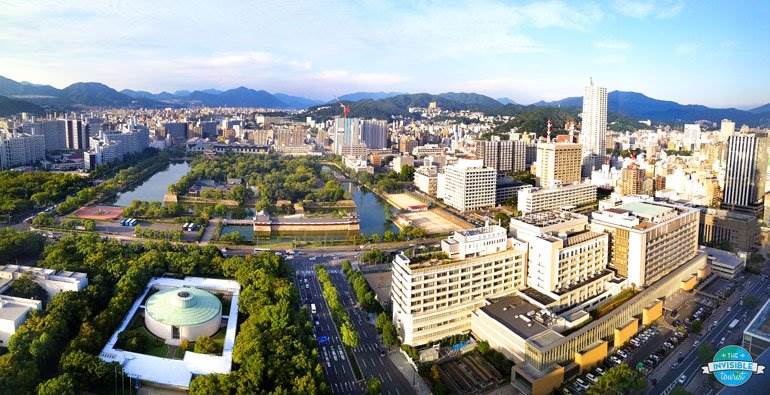
Where to eat in Hiroshima
Restaurants along the Hon-dori. Try the local okinomiyaki (savoury pancake), the best place to try this local specialty is at Okonomimura, a four-storey building packed with okonomiyaki eateries! You can’t really go wrong in here as each restaurant inside the building is its own business that specialises in cooking these their own way.
I also enjoyed sampling Japan’s famous soufflé pancakes right here in Hiroshima (and I didn’t have to wait in line). Find out where and how I did it in my guide to things to do in Hiroshima.
Want to discover more of the hidden eateries and drinking spots? For an authentic Japanese experience, you can take a Hiroshima bar hopping tour with a small group led by a local who grew up in the city. Learn more about Japanese food, culture and even make some new friends along the way!
 Okonomimura is four storeys of okonomiyaki eateries
Okonomimura is four storeys of okonomiyaki eateriesThings to do in Hiroshima
Eat, explore and shop on the Hondori. You’ll also find wonderful little souvenirs to remember your visit. Reflect at the A-Bomb Dome 原爆ドーム (UNESCO World Heritage site), be amazed by thousands of colourful paper cranes at the Children’s Peace Monument and find Jizoson. The atomic bomb struck Jizoson and left it with a nuclear shadow, incredible and eerie. You’ll also see the Peace Arch on your way to the Hiroshima Peace Memorial Museum 広島平和記念資料館. Artefacts that survived the blast are on display in the museum, including ceramics that were fused together due to the extreme heat from the explosion. It’s difficult to get your head around but the Museum does a great job of helping you gain a better understanding about nuclear bombs and their consequences. The Peace Flame located by the Peach Arch will burn until the last nuclear weapon on Earth is destroyed, and nearby are Phoenix Trees that were blasted by the atomic bomb and miraculously survived, their charred trunks hollowed by the explosion. One of the most moving places to visit in Hiroshima is the National Peace Memorial Hall for the Atomic Bomb Victims. Here you’ll learn why the symbolism of water is so a significant to many monuments in Hiroshima, listen to stories of survivors and see a huge soil sample of the city dating from 400 years until after the Peace Memorial Park was created in 1954. Seeing the blacked debris wedged beneath the soil is eye-opening. If you would prefer a local guide to show you around the city and explain the sights in more detail, a Hiroshima walking tour may be a good option for you. With a personalised touch and stories from a local who calls Hiroshima home, you’ll gain a greater understanding about this beautiful city. Lunch is included, too!NOTE: This is part of my complete meaningful & fun things to in Hiroshima travel guide, be sure to take a look for more detailed information!
OPTIONAL: Day trip from HIROSHIMA to MIYAJIMA (Itsukushima Shrine)
Itsukushima Shrine 厳島神社 is a UNESCO World Heritage site. The present shrine dates back to the mid-13th century and is one of Japan’s National Treasures. The shrine is famous for its giant floating torii gate, but there is so much more to discover here!
Getting there: Aquanet Ferry from Hiroshima Peace Park to Miyajima island, approx 45mins.
Cost: Adult roundtrip JPY 3,600.
TIP: Check the tide information before your trip to find out whether the Grand Torii Gate will be in high or low tide during your visit. At high tide, it appears to float on the water and makes for stunning photos. In low tide, you can walk right beneath it and appreciate the bright vermilion colour up close.
I’ve written a detailed guide for your Hiroshima to Miyajima day trip here! Take a look for more photos, ferry comparison with and without the JR Pass, information about the restoration work that commenced in June 2019 and what NOT to do to help make the most of your visit.
If you do make the trip over to the sacred island, this Miyajima cultural highlights walking tour with a friendly local guide will teach you the difference between Japanese Shinto religion and Buddhism, and provide you with more in-depth information about popular and lesser-known temples and shrines!
 MIYAJIMA HIGHLIGHTS: 1: Miyajima Natural Botanic Garden ~ 2 & 6: Grand Torii Gate ~ 3: Coins left for good luck between barnacles on the Grand Torii Gate ~ 4: Sacred deer roaming freely on the island ~ 5: Pagoda ~ 7: Tōrō (stone lanterns) lining a walkway ~ 8: Itsukushima Shrine
MIYAJIMA HIGHLIGHTS: 1: Miyajima Natural Botanic Garden ~ 2 & 6: Grand Torii Gate ~ 3: Coins left for good luck between barnacles on the Grand Torii Gate ~ 4: Sacred deer roaming freely on the island ~ 5: Pagoda ~ 7: Tōrō (stone lanterns) lining a walkway ~ 8: Itsukushima ShrineREAD MORE:
Meaningful Souvenirs from Japan You Can’t Return Home Without
Meaningful & Fun Things to Do in Hiroshima to Add to Your Itinerary
DAYS 12 – 14: OSAKA
Known as Japan’s foodie capital, you can literally eat and shop until you drop in Osaka! Prepare for all your senses to be delighted in this city, from the aromas of sizzling takoyaki to the dizzying sounds of Pachinko parlours and bright neon signs assaulting your eyes. Osaka was a merchant city rather than samurai so be sure to stand on the RIGHT of escalators instead of left (like the rest of the country)!
Getting from Hiroshima to Osaka
1h30 from Hiroshima on Nozomi shinkansen
Cost: Adult Nozomi ticket JPY 10,440 ea or free with the Japan Rail Pass.
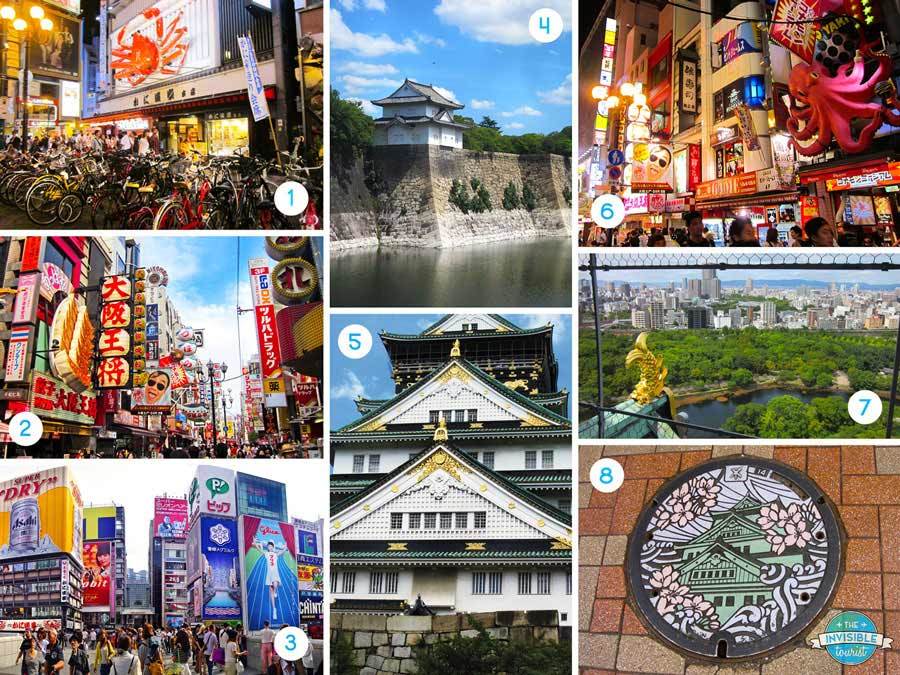 OSAKA HIGHLIGHTS: 1, 2 & 6: Dotonbori ~ 3: Glico Man and neon signs along Dotonbori River ~ 4: Osaka Castle Moat ~ 5: Osaka Castle & Museum ~ 7: View from Osaka Castle Observation Deck ~ 8: Artistic Street Drain Cover
OSAKA HIGHLIGHTS: 1, 2 & 6: Dotonbori ~ 3: Glico Man and neon signs along Dotonbori River ~ 4: Osaka Castle Moat ~ 5: Osaka Castle & Museum ~ 7: View from Osaka Castle Observation Deck ~ 8: Artistic Street Drain CoverWhere to stay in Osaka
Cross Hotel Osaka クロスホテル大阪. Just steps away from Dotonbori Arcade, restaurants and a few minutes walk to Namba station. As a business hotel it means there are many power points for charging devices which is handy.
TIP: Ask for a room facing Mido-suji (street entrance) side for a super quiet sleep!
Need more information on Osaka accommodation? Check out:
Where you can find alternative hotels in Chuo Ward, Osaka.
More reviews and compare Osaka hotel prices here.
 The main street, Dotonbori, is just a few steps away from Cross Hotel Osaka
The main street, Dotonbori, is just a few steps away from Cross Hotel OsakaWhere to eat in Osaka
My personal favourites places and things to eat in Osaka are Showa Taishu Horumon Beef BBQ and Osaka’s famous takoyaki (octopus balls)!
See the famous Glico Man over the river from Dotonbori 道頓堀, keep an eye out out for artistic drain covers (pictured below), be amazed at all the shops and how meticulously the products are arranged. Spend the day at Osaka Castle Museum 大阪城, check out the 360 degree view from the observation deck and wander the beautiful grounds. Embrace the foodie scene: The Japanese phrase kuidaore (eat ‘til you drop) is well known in Osaka as you can literally do just that! Some great places to start your foodie adventure are Shinsaibashi-suji Arcade and Kuromon Ichiba. Treat yourself to many of the local specialties or have a local show you what’s best on an Osaka foodie tour. Find Hozen-ji Yokocho: An Osaka hidden gem buried away in the quiet backstreets along with Mizukake Fudo. Don’t forget to look down at the amazingly beautiful manhole covers beneath your feet!NOTE: Be sure to check out my in-depth Osaka itinerary for more details than I’ve listed here, plus all the information you’ll need for a day trip to Nara!

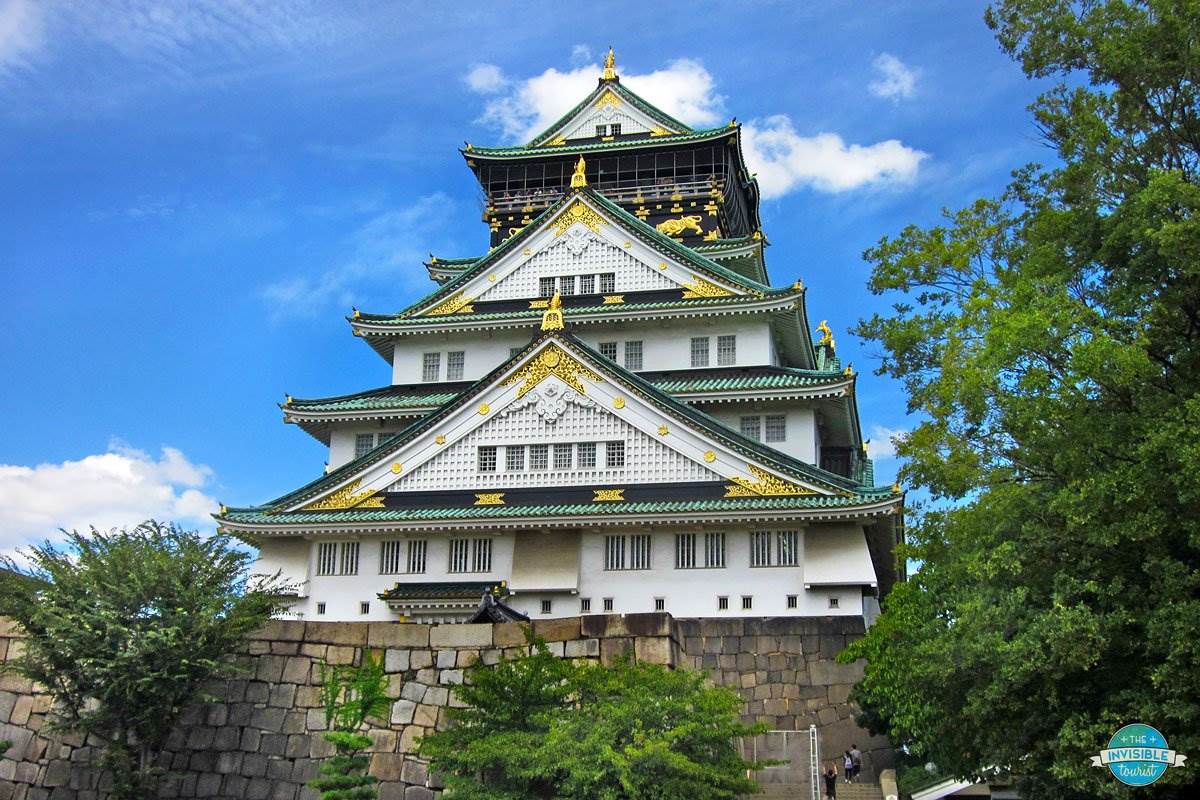
OPTIONAL: Day trip from OSAKA to NARA
Nara 奈良 was Japan’s first permanent capital in 710 AD so it holds a great historical significance. The city was heavily influenced by Buddhism and many structures reflect this.
Getting there: Yamatoji train from JR Osaka station to JR Nara station, approx 45mins.
Cost: Adult one way JPY 800 ea or free with the Japan Rail Pass.
MUST SEE: Todai-ji Temple 東大寺, a UNESCO World Heritage site and the largest wooden structure in the world. Be amazed by the giant bronze Buddha and see if you’re small enough to fit through the pillar with a hole the size of Buddha’s nostril for good luck! ~ Yoshikien Gardens are breathtaking ~ Nigatsu-do for views over Nara ~ Kasuga-Taisha Shrine 春日大社 for 3,000 stone lanterns ~ Kofuku-ji 興福寺, family temple of the Fujiwara clan.
TIP: For more locations nearby Osaka that aren’t Universal Studios, check my detailed guide to inspiring day trips from Osaka that covers popular destinations and alternatives to popular spots.
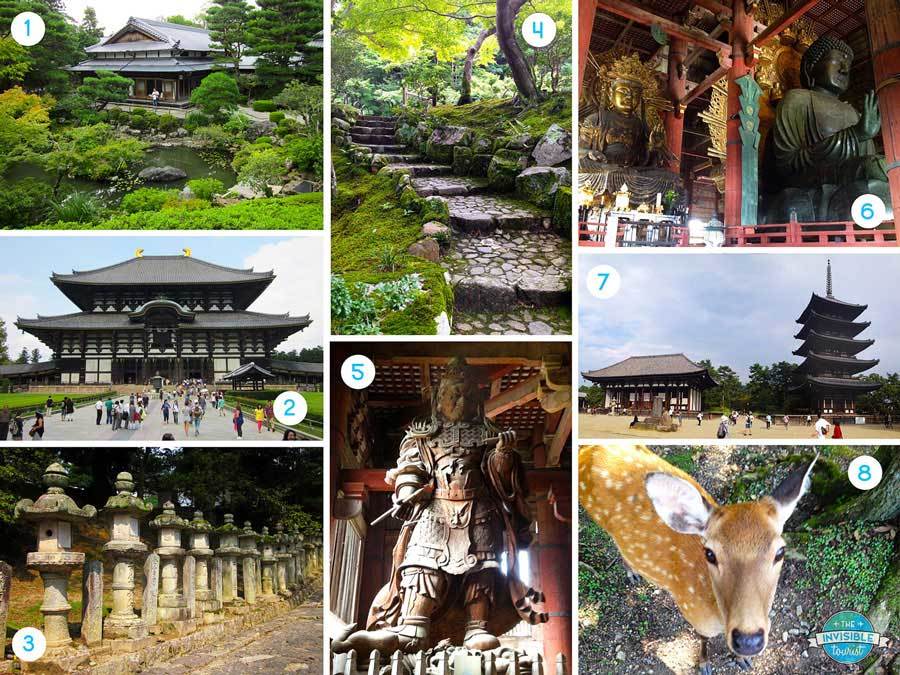 NARA HIGHLIGHTS: 1 & 4: Yoshikien Gardens ~ 2: Tōdai-ji Temple, home of the bronze Buddha ~ 3: Some of the 3,000 tōrō (stone lanterns) at Kasuga-Taisha Temple ~ 5: One of Buddha’s minders at Tōdai-ji ~ 6: Bronze Buddha ~ 7: Kōfuku-ji pagoda, first built in 730 AD (rebuilt 1426).
NARA HIGHLIGHTS: 1 & 4: Yoshikien Gardens ~ 2: Tōdai-ji Temple, home of the bronze Buddha ~ 3: Some of the 3,000 tōrō (stone lanterns) at Kasuga-Taisha Temple ~ 5: One of Buddha’s minders at Tōdai-ji ~ 6: Bronze Buddha ~ 7: Kōfuku-ji pagoda, first built in 730 AD (rebuilt 1426).READ MORE:
3 Days in Osaka Itinerary: Complete Guide + Nara Day Trip
6 Unique Experiences in Takayama Old Town (By a Local)
The Venice of Japan: Amazing Things to Do in Kurashiki
Day 14: OSAKA to TOKYO
Once you arrive back in Tokyo from Osaka, you can spend the day revisiting a favourite neighbourhood, exploring a new one or taking a day trip from Tokyo. I have some exciting suggestions below so read on!
Getting back to Tokyo from Osaka
2 hours 30 minutes from Osaka on Nozomi shinkansen
Cost: Adult Nozomi ticket JPY 14,450 ea or free with the Japan Rail Pass.
Where to stay in Tokyo
Different neighbourhood, this time Ginza 銀座 for 1 night. I can recommend the hotel (Mercure Hotel Ginza メルキュールホテル銀座東京) but be aware that this ritzy neighbourhood feels strikingly similar to most New York City neighbourhoods. You don’t really feel like you’re walking the streets of Japan.
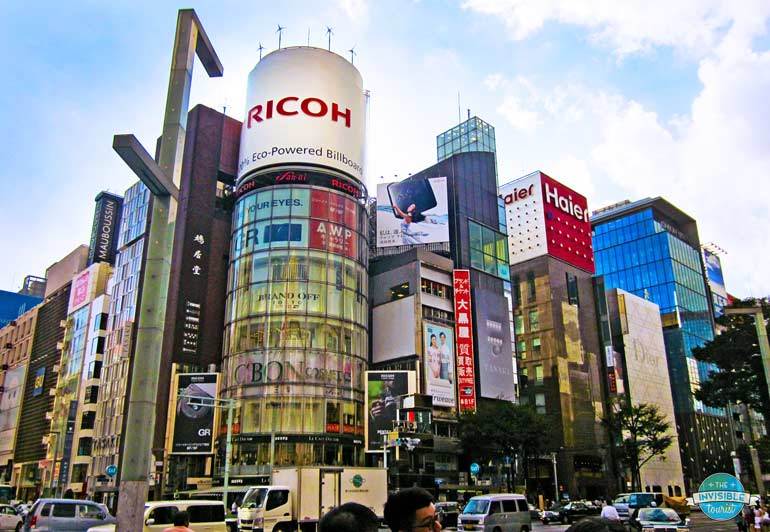
Day trips from Tokyo
Here’s some ideas for how to spend your last day in Tokyo:
Kamakura 50 minutes from TokyoRead my full guide to a Kamakura day trip itinerary! Japan’s ancient capital with many temples and shrines, Kamakura is popular for its famous giant Buddha and easy hikes nearby. Discover hidden caves, Hasedera Temple and enjoy a traditional lunch on this Kamakura Old Capital Walking Tour. Kawaguchiko (Fuji Five Lakes) 2 hours from Tokyo
Lavender fields and reflective lakes paired with a backdrop of Mt Fuji means you really can’t go wrong! Fujiyama Snow Resort 2 hours from Tokyo
Why not try your hand at skiing in Japan’s powder! Best of all, there are ski runs for all levels and Mt Fuji will be watching over you throughout the day. You can take this Snow Town Yeti tour that includes a coach roundtrip from Shinjuku. Nikko 2.5 hours from Tokyo
This stunning UNESCO World Heritage site is home to many temples and shrines (pictured below) nestled within nature’s finest scenery. You can easily get there with this popular day trip to Nikko. Nagano 3 hours from Tokyo
Known as being a ski town, Nagano sure does delight in the summer months, too! Here you can visit the Jigokudani Snow Monkey Park (and their newborn babies in summer), or combine this with a tour including sake tasting and a visit to Zenko-ji Temple. Tokyo Disneyland & DisneySea 25 minutes from Tokyo
If you’re into all things Disney, these theme parks are the obvious choice for you. Don’t forget to book your Disney tickets in advance!
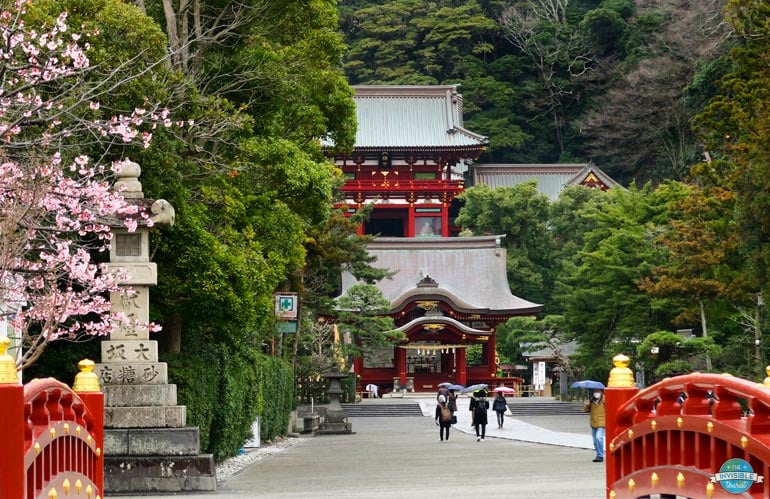
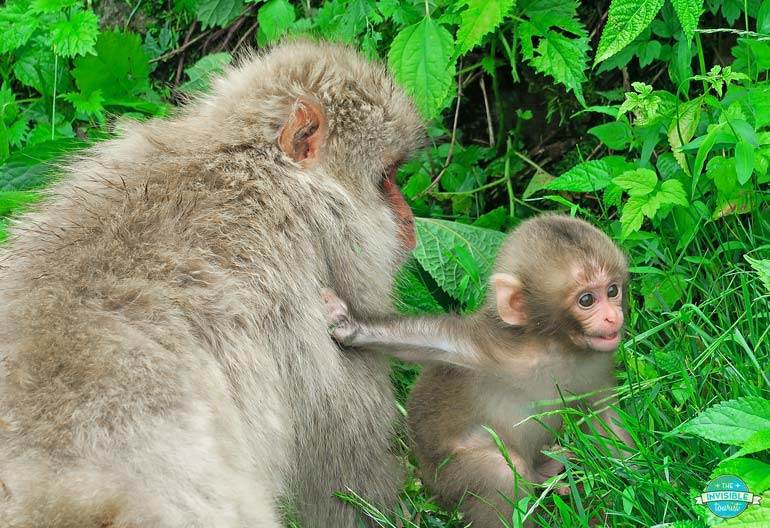 TOP: Stunning Kamakura ~ BOTTOM: Summer is the perfect time to see newborn snow monkey babies near Nagano
TOP: Stunning Kamakura ~ BOTTOM: Summer is the perfect time to see newborn snow monkey babies near NaganoDay 15: TRANSIT to Tokyo
Spend half day in Tokyo before heading to airport for your night flight home. I’m sure you’ll be sad to leave Japan!
Getting back to Narita Airport from Tokyo
Getting there: Narita Airport to Tokyo via Narita Express, approx. 1 hour.
Cost: Adult Narita Express Ticket JPY 3,020 ea
You can also get the Narita Airport Limousine Bus back to the airport. For more information and prices, click here to book your Narita Airport Limousine tickets.
Getting back to Haneda Airport from Tokyo
Getting there: Haneda Airport to Tokyo (Hamamatsucho) via Tokyo Monorail, 15 minutes.
Cost: Adult JPY 500 ea
Arrive home on Sunday. Head back to work on Monday wanting to do it all again!!

Things to keep in mind during your two weeks in Japan
Contrary to popular belief, you DO NOT need to buy a JR Pass before you visit Japan.
Flights to Tokyo
If possible, book a red-eye (overnight) flight. Most international flights will land at Tokyo Narita Airport. Get a good sleep and you’ll wake up the next morning in Japan saying “こんにちは” (konnichiwa) ready for a full day of action! Choosing night flights means maximising every waking moment having a blast exploring.
Do I need a Japan Rail Pass? Here’s how to catch the Shinkansen (Bullet Trains) in Japan
If you have calculated how many shinkansen trips you’ll be using on your trip, the JR Pass may be for you. By purchasing this pass, train travel across JR trains in Japan (where your pass is valid) is free. Prices vary depending on whether you purchase a 7 day, 14 day or 21 day pass.
I personally have and haven’t used the pass during my Japan trips for reasons I explain below, but if you think it will benefit you you make sure you purchase a JR Pass here before you enter Japan (this is important because they are more expensive once you arrive!)
The types of Shinkansen in Japan
So, contrary to popular belief here’s why you may not need to buy a Japan Rail Pass before you visit, especially if you’re travelling with a mid range budget.
There are 3 kinds of Shinkansen in Japan. Here are some fast facts:
Nozomi のぞみ and Mizuho みずほ Shinkansen reach speeds of 300km/h Hikari ひかり Shinkansen reach speeds of 230km/h Kodama こだま Shinkansen stop at all stations.The Nozomi and Mizuho Shinkansen are the fastest trains but are not covered by the pass. Additionally, Metro tickets in all cities are only a few hundred yen each way (USD 2.70) so I never bothered with the pass.
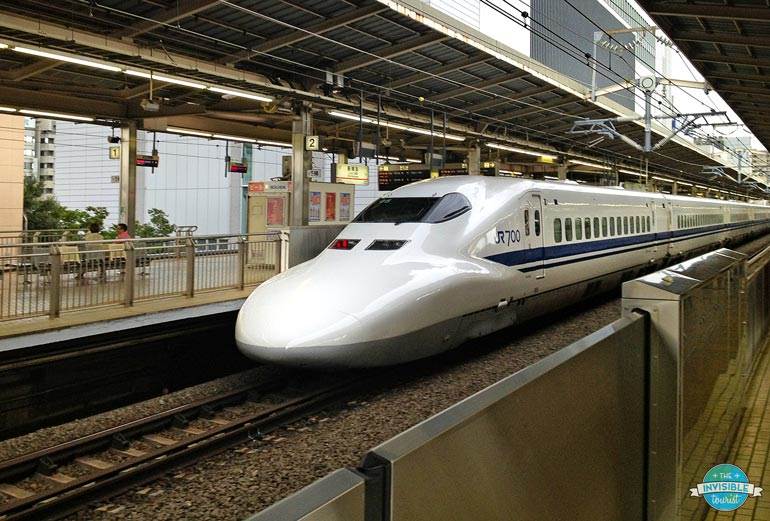
How much time you can save using Nozomi Shinkansen
Over the duration of this 2 weeks in Japan trip you can save 3 hours of time using Nozomi over Hikari trains and save 5 hours of time using Nozomi over Kodama trains. Personally, I prefer to pay as I go and not sacrifice exploration time trying to save a small amount of money.
With only 15 days (including all travel time), every hour counts. My advice would be to weigh up the cost saving vs extra travel time and what that means to you before you consider purchasing a Japan Rail Pass. If you’re worried about lengthy queues to purchase tickets, don’t be.
Purchasing Nozomi Shinkansen tickets
It’s simple to purchase Shinkansen tickets a day or so in advance from the stations, especially not during peak times. I can honestly say doing it this way meant I never had to wait long to purchase tickets and I was ready to go on the day of travel – plan ahead and you’ll be sweet!
TIP: Buy Nozomi Shinkansen tickets a few days in advance to ensure you will get reserved seating. When buying from the ticket offices at train stations it’s useful to have pre-printed information in Japanese to give to the sales clerk. This is easy with a little help from Google Translate. If you know the time you’d prefer from the timetables I’ve linked below, add that in too. That way nothing will be lost in translation and your transaction will be swift and efficient!
 Shinkansen Ticket Info Example
Shinkansen Ticket Info ExampleYou can find the Japan Rail (JR) shinkansen timetables used for this itinerary here: Westbound from Tokyo & Eastbound from Hiroshima.
Busy Periods and Public Holidays in Japan for 2020/21
Once you know you’re able to visit Japan, it’s wise to book accommodation and flights well in advance to avoid disappointment during what’s expected to be busy travel periods.
Late March – late April is the popular cherry blossom season so plan in advance. Find out when is the best time to visit for cherry blossoms depending on the locations you wish to view. In late April – early May, Golden Week is one of the busiest times of year for travel in Japan, mainly from locals travelling around the country during these holidays. The holidays begin on 29th April and will run through to 5th May. Be prepared for crowds. Additionally, from 19th – 22nd September will be Silver Week. This happens every five to six years when a weekend aligns with 3 consecutive Japanese holidays so make sure you are prepared for crowds during this time, too. From 23rd July – 8th August 2021, all eyes of the world will be on Tokyo for the Olympic Games. From 24th August – 5th September 2021, Tokyo will showcase the Paralympic Games.
Etiquette in Japan: Good to Know
Did you know there are many do’s and don’ts you should follow in Japan to avoid looking like a tourist? There’s quite a number of differences compared with the Western culture! Not only is practising the correct manners and behaviour polite, it will earn you massive brownie points with the locals and you’ll make the most of your trip. With my guide below, feel confident travelling in Japan knowing you won’t be doing something wrong that you didn’t know about!
Be sure to check out my 30 crucial do’s and don’ts in Japan – how many are you aware of?
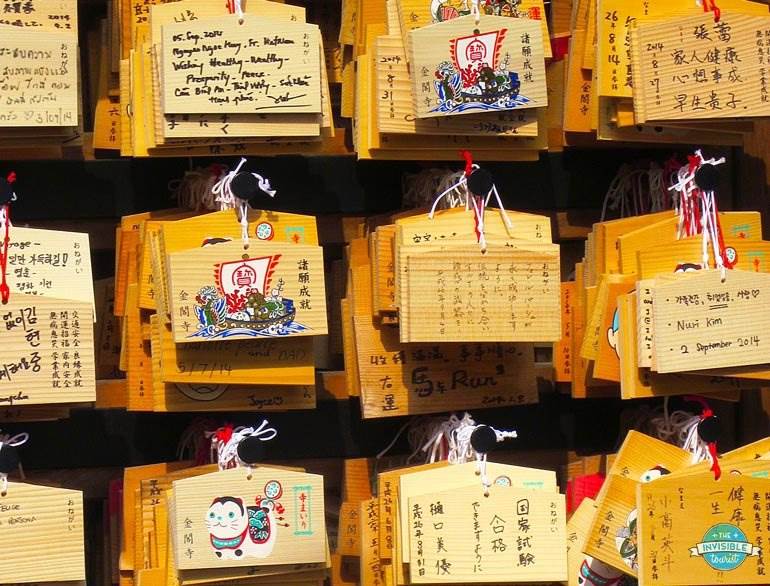
Concluding my two weeks in Japan itinerary
…we never felt rushed. Because we were prepared it allowed us to leisurely stroll between many attractions and enjoy taking our time uncovering the wonders that make this incredible country so unique.
The last day in Tokyo isn’t necessary from a sight-seeing perspective but personally I always like to ensure there is a buffer so I won’t miss my flight home. Although highly unlikely in Japan, it’s wise to factor in train delays in case something unforeseen (like an earthquake) were to happen.
You don’t want to be stuck down in Hiroshima or Osaka with no way of getting to Tokyo for your flight that same night. Why stress? Planning this way allows you to spend extra time exploring Japan’s largest city. Go visit a new neighbourhood or revisit one of your favourites before you fly home!
Although it may look like my travel buddy and I crammed a lot into our 2 weeks in Japan, I can honestly say we never felt rushed. Because we were prepared it allowed us to leisurely stroll between many attractions and enjoy taking our time uncovering the wonders that make this incredible country so unique. Travelling The Invisible Tourist way is about being efficient and making the best use of your travel time.
 Take your time in Japan to discover hidden gems, such as Gio-ji in Kyoto
Take your time in Japan to discover hidden gems, such as Gio-ji in KyotoWhat about the language barrier?
⬇️ Download your FREE Japanese for tourists CHEAT SHEET!
Worried about the language barrier in Japan? Don’t be! Head over to my guide on Japanese for Tourists to download your FREE PDF of 20+ useful phrases, created specifically for visitors to Japan. Simply print out this super handy cheat sheet to take with you, or store it on your phone for offline use when you’re adventuring around Japan!
If you’re worried about the language barrier, there’s no need to be. You’ll find hotel staff speak English and in Tokyo many people do, too. They may just be shy to speak to you in English as the Japanese are perfectionists but are very eager to help.
Kindly greet someone in Japanese first before using English if you can. The further south from Tokyo you venture however, English is less widely spoken and understood. Hand gestures go a long way! In terms of getting around there are signs in English and the Metro is colour coded – very simple to navigate without knowing Japanese.
TIP: Find out how I quickly learnt Japanese for travelling and my favourite words in Japanese with interesting meanings to help you learn more about the culture through language.
 Many Metro signs are in Japanese and English
Many Metro signs are in Japanese and EnglishSo there you have it with my 2 weeks in Japan itinerary! I’m a little biased, but I firmly believe visiting these cities in a loop as described here is the best itinerary for Japan. After much research I concluded this was the most efficient way to see all the main sights (and also wander off the beaten path) without being rushed or short on time.
2 weeks in Japan cost
To make things even easier for you, I’ve added up the totals I’ve mentioned in this itinerary to give you an overall 2 weeks in Japan cost. This total is travelling with a mid range budget.
By all means, don’t take this as absolute gospel, my preferences may differ to yours in terms of using the JR Pass (and the exchange rate may alter a little) but feel free to use it as a ballpark figure. You can aways spend more or less than this!
2 weeks in Japan cost for two adults
Flights – USD 2,374 / JPY 252,109From Sydney, Australia to Tokyo Narita including a premium economy leg (this price will obviously vary depending where you’re flying in from) Hotels – USD 2,148 / JPY 288,286
All 3-4 star, twin share Long Distance Trains – USD 1,195 / JPY 126,940
All Nozomi shinkansen trips, express train to Hakone, Ferry to Miyajima etc Total for 2 adults, 2 weeks excluding spending money: USD 5,717 (approx, depends on exchange rate). In terms of spending money, I usually allow around USD 300-400 per week for myself. This includes Suica card top ups, temple entries, convenience store meals, small souvenirs etc. You can easily spend a lot more or a lot less, it’s entirely up to you! I’m quite the splurger on holidays and even I come home with a small amount of change afterwards.
Let’s get your 2 weeks in Japan itinerary started now!
What are you waiting for? Take the next step and get your Japan itinerary planning started by searching for hotels in Tokyo here. If you’re after more inspiration, I have many more travel guides and itineraries here in my full Japan archive. From finding hidden gems, detailed city guides, best time to visit for cherry blossoms and more, I have your Japan trip covered!
If you’re wanting to learn the tips and tricks I personally use to be an Invisible Tourist, be sure to have a look through my complete “Be Invisible” archive or learn my strategies for how to “blend in” anywhere around the globe by reading my #1 Amazon New Release Book!
Are you thinking of heading to Japan? What are your thoughts on this 2 weeks in Japan itinerary or do you have any questions about it? I’d LOVE to hear if you use this itinerary on your visit! If you found this helpful please share it with your friends or come and join me on Facebook, Pinterest, Instagram and TikTok for more Japan inspiration!
Until next time,

Like it? Pin it! 📌

This 2 weeks in Japan itinerary contains some affiliate links, at no extra cost to you. I may earn a small commission if you decide to make a purchase and if you do, thanks for your support! This helps with the costs of running my blog so I can keep my content free for you. As always, I only recommend a product or service that I genuinely love and use myself!
Australian-based Alyse has travelled "The Invisible Tourist Way" for thirteen years and hopes to encourage fellow travellers to do so, too. Based on her travels to 250+ cities across 32 countries, through her blog she shares passionate advice about responsible travel, history and preserving local cultures for more enriching experiences. Her dreams? Always about the next destination and how to make the most of it by "blending in".

 ShanonG
ShanonG 

